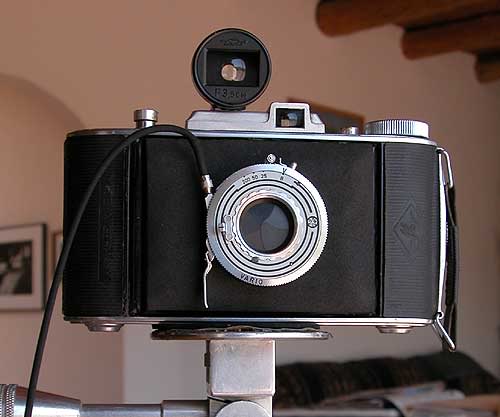| My Pinhole Camera Gallery Why Pinhole? Pinhole Links back home | |
|
People have made pinhole cameras from every conceivable container; light-tightness and a small hole are about the only real requirements. I chose to make mine from a modified folding camera, an old Agfa Billy Record that seemed unlikely to take pictures again due to a terminally deteriorated bellows. I cut out the bellows and associated hardware, hacksawed a hole in the front door panel where I fitted the shutter without the lens, and I added some adhesive-backed foamie material to prevent light leaks. The pinhole is in a disk of thin metal laid in front of the shutter blades, and held in place by a foam-rubber washer. I originally had the pinhole located behind the shutter, but found that the front of the lens mount tube was causing quite a bit of vignetting of the image.
I tried three different pinholes with this camera. One I made myself, one was a precision drilled pinhole purchased from a fellow on ebay, and the other was a laser-drilled hole. They all gave me very similar results. The camera is very convenient to use as it gives me eight big 6x9cm frames on a roll of 120 film. The mechanical shutter with its cable release socket is a little easier to manage than a simple flap shutter that many put on pinhole cameras. The tripod mount permits attachment of a light-weight tripod with telescoping legs, and the whole kit fits easily into a small camera bag, usually along with a couple conventional film cameras and accessories. My previous attempt at making a pinhole camera was based on modifying an old Tower box camera. That actually worked out pretty well, too, but I prefer the shorter focal length of my Billy Record, which is about 38mm. The wide-angle effect from the shorter focal length seems a nice complement to the character of the pinhole images. Both cameras gave me surprisingly sharp images, perhaps a little too sharp, in fact, as one would be hard-pressed to distinguish the resultant images from a normal wide-angle lens without using a loupe or making a big enlargement. Some of my pinhole images from the last camera actually will support enlargement up to 13x19 inches, though I have found that I generally prefer prints on glossy paper at about 5x7 inches. |


|